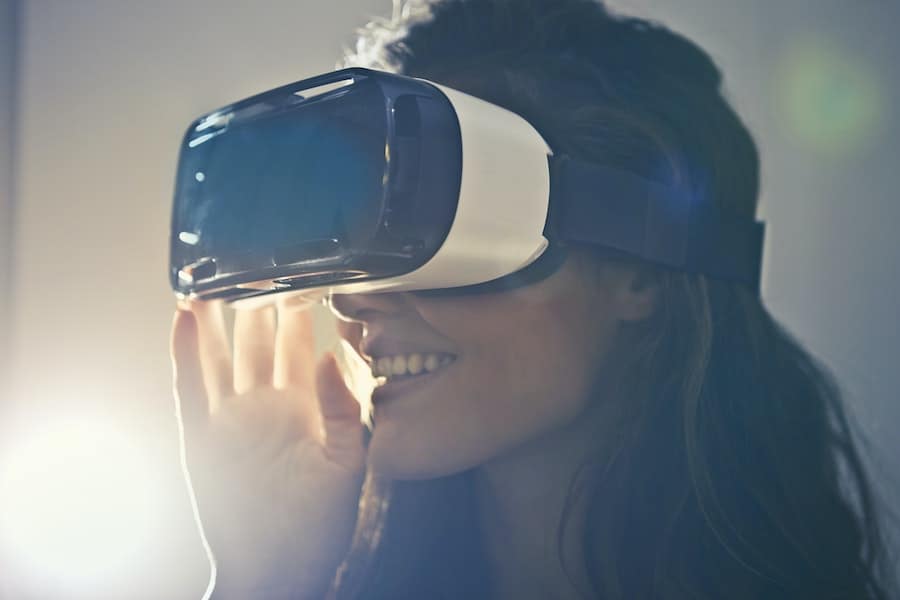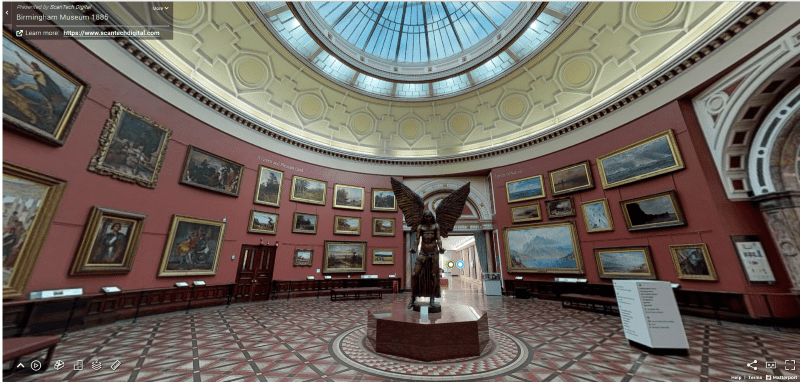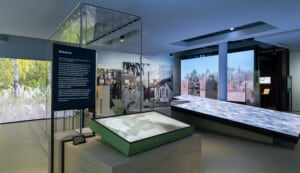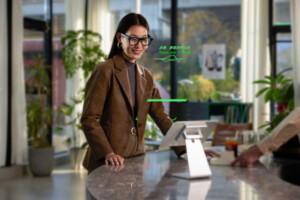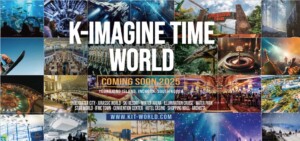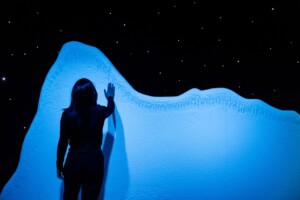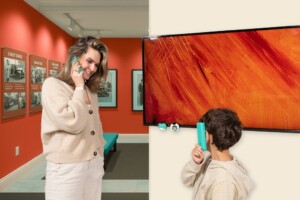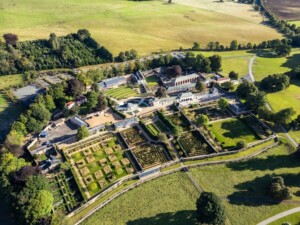For instance, one VR experience that has made headlines in recent years is Mona Lisa: Beyond the Glass at the Louvre Museum, a collaboration with HTC Vive Arts. Part of the Louvre’s Leonardo da Vinci exhibition in 2019/20, it brought to life the story of the iconic Mona Lisa.
Meanwhile, visitors in London have enjoyed VR experiences at the Natural History Museum. And museum lovers in the US can be immersed in unique content at Philadelphia’s Franklin Institute.
So, why are museums adding VR to their offer and what are the benefits? We take a closer look, as well as exploring some examples from around the sector.
Online engagement in the time of COVID-19
VR experiences, such as virtual tours, aren’t exactly new to the museum world. However, they have made a lot of headlines this year. This is due to the various COVID-19 lockdowns that took place across the world.
For museums that were forced to close as a result of the global pandemic, these virtual tours provided a way to keep visitors engaged. Plus, they had numerous benefits for the public too, from education to wellbeing.
Many museums were already providing virtual tours through Google Arts & Culture. This online platform gained much extra notoriety during the coronavirus outbreak. It allows people to view high-resolution images and videos of artworks and cultural artefacts from anywhere in the world.
There are over 2000 museums and cultural institutions using the platform to provide virtual content. This includes the Guggenheim Museum in New York, the Musée d’Orsay in Paris and The National Museum of Modern and Contemporary Art in Seoul.
Benefits of museum VR experiences
One huge benefit for museums in using VR experiences is that it allows them to bring objects, scenes and stories to life. This often makes it easier for visitors to understand them or put them in context.
For instance, this technology can be used to digitally restore famous sites such as the Colosseum in Rome. Or to transport visitors back in time, for example, to Pompeii before the eruption of Mount Vesuvius. It enables people to feel part of the exhibition, rather than being a passive viewer.
For those wanting to travel a little further afield, VR can also help us to explore other terrains. For example, the surface of the moon or the deepest oceans.
Furthermore, VR experiences can help museums reach new audiences, and engage with people from around the world. Here are some examples of innovative ways that museums have used this technology to enhance their visitor offer:
The Renwick Gallery, Washington D.C.
The Renwick Gallery of the Smithsonian American Art Museum in Washington D.C. provides a way of exploring its WONDER exhibition in VR. Using a free app, called WONDER 360, visitors can use their own device to view 360° 3D panoramic views of the gallery, alongside video interviews with the curator and some of the artists.
The WONDER exhibition, which ran from November 2015 to July 2016, was hugely popular. It featured stunning gallery-sized installations. These were created by nine leading artists, in order to celebrate the space itself.
Thanks to VR technology, the works by Jennifer Angus, Chakaia Booker, Gabriel Dawe, Tara Donovan, Patrick Dougherty, Janet Echelman, John Grade, Maya Lin, and Leo Villareal are available to experience in a whole new way. Even though the physical exhibition at the museum has ended.
“Renwick Gallery WONDER 360 is our first major experiment with VR. We’re excited to keep exploring the potential of this emerging technology,” said Sara Snyder, chief of the museum’s media and technology office, when the app was initially released.
“The app captures the ‘WONDER’ exhibition as a moment in time and lets you carry the beauty of that experience around in your pocket, anywhere in the world. It represents a whole new way of sharing art with the public.”
The National Museum of Natural History, Paris
Since 2018, visitors to the National Museum of Natural History in Paris, France, have been able to enjoy a fascinating VR experience, as part of a new permanent exhibition. The Cabinet De Réalité Virtuelle (The Cabinet of Virtual Reality) was the first permanent museum room in the country dedicated to VR technology.
Once they enter the Cabinet of Virtual Reality, guests enjoy a specially designed programme: Journey into the Heart of Evolution. This allows them to go on a unique adventure. Here, they will discover the links between species and can zoom in on different creatures to learn more.
The room is home to five VR stations, each with an HTC Vive virtual reality system. This means that five visitors can take part at the same time. This use of technology is a way for the museum to illustrate complex concepts in a new way, making them come to life in front of their visitors’ eyes.
There is a tactile mat on the floor so that the participants are aware of the area that they must stay within. To ensure that the experience is as immersive as possible, there is soundproofing around the room. This is to keep out the sounds of the rest of the museum. Dynamic lighting also guides visitors to the VR stations.
The National Czech and Slovak Museum, Cedar Rapids
In 2018, one museum in the US turned to the local community for help in creating a new VR experience. The National Czech and Slovak Museum & Library in Cedar Rapids, Iowa, used VR in its Guts & Glory: The War Train that Shaped a Nation exhibition. This ran from April – December 2018.
The exhibition told the story of 60,000 Czech and Slovak soldiers who were stranded in Russia at the end of WWI. They banded together, seized the Trans-Siberian Railway, fought their way 5,000 miles to the port of Vladivostok and provided crucial support for the allies, as well as being instrumental in the formation of their new homeland: Czechoslovakia.
Students from Cedar Rapids Metro High School designed replica train cars for the exhibit. Meanwhile, Iowa BIG students worked on the VR experience with the museum. Visitors were able to don a VR headset and put themselves in the shoes of a soldier on the train.
The Australian Centre for the Moving Image (ACMI), Melbourne
Before closing for redevelopment in 2019, ACMI was home to a dedicated VR lounge, inside its permanent Screen Worlds exhibition. This opened in 2017, building upon the museum’s considerable experience in the world of VR.
“As the national museum for film, TV, games digital culture and art, ACMI is fascinated by the rapid evolution of VR and the new ways practitioners are engaging audiences through this platform,” said ACMI Director and CEO, Katrina Sedgwick, speaking at the time of the VR lounge’s opening.
“Alongside our vibrant commissioning program, the VR Lounge is the latest addition to our free, permanent exhibition, Screen Worlds. We are delighted that the first showcased work is the beautiful The Turning Forest, created by VRTOV in collaboration with BBC Research and Development. It is a stunning work which will delight people young and old.”
Other VR works exhibited at ACMI include Prehistoric VR by Erth Visual & Physical Inc., Sandpit’s play Ghost, Toast and the Things Unsaid with Google Creative Lab and Grumpy Sailor, and Stuck in the Middle With You, an immersive dance experience by renowned choreographer Gideon Obarzanek and award-winning filmmaker Matthew Bate.
In 2019, Sedgwick spoke to Blooloop about the redevelopment of ACMI, and how it will continue to use new technology such as VR and AR to tell stories.
The Tate, London
One of the Tate’s most popular exhibitions of recent years was its Modigliani retrospective of 2017/18. Visitors to this were also able to enjoy a unique VR experience. This allowed the museum to show the artist and his life in a new way.
Modigliani VR: The Ochre Atelier was a recreation of the artist’s Paris studio, as it would have been when Modigliani painted there 100 years ago. Guests could enter a 3D model of the studio and put themselves in the artist’s shoes.
While the studio space itself still exists, it has changed much over the last century. However, using it as a template, alongside historical documents and the artist’s works themselves, the museum was able to create a faithful recreation. This experience was a unique way of adding extra context to the blockbuster exhibition. It helped to give visitors a feel for Modigliani’s last months.
Speaking of the experience, Hilary Knight, head of digital content at Tate, said that VR can be a useful tool for museums: “I think we’ve demonstrated that there a place for virtual reality in the gallery, as a way of helping people to connect on an emotional level – understanding art through feeling, as well as learning facts.
“I think there is something interesting about using VR to take people to places they couldn’t otherwise access. It’s also something that an increasing number of artists are exploring.”
Challenges with museum VR experiences
Some of the early problems with VR, for instance, feelings of nausea, have improved greatly over the past few years as technology improves. But it is still something that museums need to bear in mind.
However, one recurring issue has taken on a new significance in the light of COVID-19: hygiene. In a post-pandemic world, visitors are more aware than ever of the spread of germs and will be unlikely to want to share hardware such as headsets without being able to trust that stringent cleaning procedures are in place.
For those museums who rely on VR headsets, rather than presenting experiences that can be accessed from people’s own mobile devices, this should be taken into consideration.
How effective are museum VR experiences?
Museum VR can enhance the visitor experience, presenting information in an engaging way. But, the overall goal needs to be clear. The technology must add something new or enhance what is already there.
Visitors will be able to tell if a museum is using VR just for the sake of it. However, when used correctly, VR technology can create something genuinely memorable and interesting.
During the global pandemic, people flocked to virtual museum and art gallery tours as a way to escape the lockdown, while staying safe in their own homes. But can VR truly replicate the emotional experience of a real-life museum visit?
Researchers from Italy and Spain conducted an experiment to measure people’s emotional response to a virtual museum setting. Half of the study’s participants attended an exhibit in person. Meanwhile, the other half viewed a detailed reconstruction of the same exhibit through a VR headset. During the experience, the researchers took electroencephalographic (EEG) and electrocardiographic (ECG) measurements.
They found that there was not a huge difference between the two readings. In fact, the VR participants showed slightly more excitement. Of course, this could have been due to the technology itself being new and exciting.
See also: Museums bring history and culture to life with AR technology
Drawing a crowd with VR
When looking at how effective museum VR experiences are at driving up visitor numbers, it might be worth noting that in 2019 – 2020, The Louvre’s Leonardo da Vinci exhibition enjoyed a record-breaking number of visitors. Around 1.1 million guests attended the four-month-long exhibition, which commemorated the 500th anniversary of the artist’s death.
A celebration of such a well-known artist at the world’s most popular museum was always going to draw a crowd. But the record-breaking success might also be due, in part, to the draw of the museum’s Mona Lisa: Beyond the Glass VR experience. This was a key part of the landmark exhibition.




